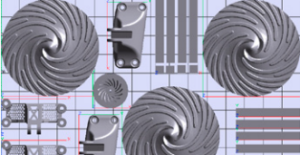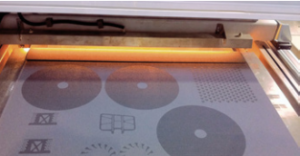CARBOPRINT: ExOne Using Binder Jet 3D Printing to Produce Carbon and Graphite Components with SGL Group
 The ExOne Company, which provides 3D printed products to industrial customers and manufactures the M-Flex metal production 3D printer platform, has long had its eye on materials, partnering with Jenny Wu to 3D print an interlocking steel necklace and adding a stainless steel alloy to its offerings.
The ExOne Company, which provides 3D printed products to industrial customers and manufactures the M-Flex metal production 3D printer platform, has long had its eye on materials, partnering with Jenny Wu to 3D print an interlocking steel necklace and adding a stainless steel alloy to its offerings.
This week the company has announced that it is working with SGL Group, a leading manufacturer of products and materials made from carbon, to use its binder jet printing technology to 3D print carbon and graphite components. The two companies are bringing these components to the market under the CARBOPRINT brand name.
The initial material development study has been completed for CARBOPRINT, and after an early introduction to a larger application specialist audience at January’s Berlin Waste Management and Energy Conference, it’s now available to customers.
“ExOne has formed a unique collaborative relationship with SGL Group who has developed a material that is ideally suited for our binder jetting technology. Each party brings their expertise: SGL Group offers extensive knowledge on raw material and powder preparation, as well as versatile technologies for post-processing carbon components. As the leading supplier for industrial binder jetting technology, ExOne contributes its competencies in 3D printing,” said Rick Lucas, ExOne’s CTO.
“This technology enables not only the production of small prototypes, but also efficient serial production and fast development of customer-specific solutions.”
SGL’s extensive carbon expertise is combined with ExOne’s 3D printing technology to make the CARBOPRINT family, which can be put to use in rapid and economic production of prototypes and small series batches for industries that deal with high-temperature and mechanical applications, like chemicals, glass, and metal.
While we may groan when we hear the words post-processing, the carbon body is porous right after printing, so post-processing methods like silicon or metal infiltration and polymer impregnation are very important when completing these components. This allows the varying material properties to adjust to their specific application.
There are a total of four CARBOPRINT materials, each with various unique material properties:
- CARBOPRINT C – carbon and graphite, low density and open porosity
- CARBOPRINT M – metal carbon composites, good electrical and thermal conductivity
- CARBOPRINT P – polymer carbon composites, accelerated development and good gliding
- CARBOPRINT Si – ceramic carbon composites, high hardness and temperature resistance
Most conventional carbon components are made through traditional subtractive machining processes. But there are many benefits to 3D printing this material, such as the possibility of intelligent functions, like heating and thermal management, and manufacturing components will be imbued with the specific properties of graphite and carbon, like mechanical strength, low weight, electrical and thermal conductivity, and low thermal expansion. In addition, 3D printing components with binder jetting technology allows users to manufacture large industrial components, and create complex designs at no extra cost.
- Customer design file in 3D-CAD format.
- Binder jetting building up carbon body.
The two companies will be starting CARBOPRINT component development and production with selected customers. Thanks to carbon’s basic properties, like electrical and thermal conductivity and high chemical stability, the first trial components 3D printed by SGL and ExOne, such as siliconized 3D printed carbon pump components and heat exchangers for distillation columns, are currently being developed for testing in the high-tech fields of environmental technology and chemical apparatus construction.
Discuss this and other 3D printing topics at 3DPrintBoard.com, or tell us your thoughts in the comments below.
[Images via SGL Group]
Subscribe to Our Email Newsletter
Stay up-to-date on all the latest news from the 3D printing industry and receive information and offers from third party vendors.
You May Also Like
3D Printing Unpeeled: New Arkema Material for HP, Saddle and Macro MEMS
A new Arkema material for MJF is said to reduce costs per part by up to 25% and have an 85% reusability ratio. HP 3D HR PA 12 S has been...
3D Printing News Briefs, January 20, 2024: FDM, LPBF, Underwater 3D Printer, Racing, & More
We’re starting off with a process certification in today’s 3D Printing News Briefs, and then moving on to research about solute trapping, laser powder bed fusion, and then moving on...
3D Printing Webinar and Event Roundup: December 3, 2023
We’ve got plenty of events and webinars coming up for you this week! Quickparts is having a Manufacturing Roadshow, America Makes is holding a Member Town Hall, Stratafest makes two...
Formnext 2023 Day Three: Slam Dunk
I’m high—high on trade show. I’ve met numerous new faces and reconnected with old friends, creating an absolutely wonderful atmosphere. The excitement is palpable over several emerging developments. The high...



































